There are about 100 cricket species that are known to reside in the U.S., but even fewer are easily found in populated areas. In St. Louis, 3 species are known to cause the most problems for homeowners and business-owners alike.
 House Crickets – Acheta domesticus
House Crickets – Acheta domesticus
Despite their name, house crickets are mainly driven to live indoors when the weather turns cold. Otherwise, they live in garbage dumps and in warm areas outside. These crickets are light brown and grow up to one inch long. The three dark bands across their heads are their telltale markings. House crickets can survive indoors as long as they have food and water, and like to stay in the warmer parts of the structure. House crickets feast on dead insects, pet food, silk, wool, cotton, and any food-stained material.
 Field Crickets – Gryllinae
Field Crickets – Gryllinae
These crickets live up to their name by living in fields most of the time, but they can venture indoors when they see lights or feel the warmth. Field crickets are black and up to 1.25 inches long, with rear wings that protrude beyond their back legs. Due to their primary diet of crops, field crickets are no friend to farmers. They also eat dead insects, fur, cotton, and silk, but tend to prefer vegetation above all. While field crickets thrive outdoors with their diet and mating, they are just like other crickets with their need for a warm winter shelter.
 Camel Crickets – Ceuthophilus spp.
Camel Crickets – Ceuthophilus spp.
These large brown crickets, known for their creepy heads and huge back legs, are a nightmare pest for many people. However, these crickets are generally the least destructive of the three. They stick to fungus, dead insects, organic matter, and papery items. Camel crickets usually live in a damp, dark setting that is cooler, like under logs or in basements. It can be difficult to find these 1.5-inch-long crickets because they differ from other crickets in one notable way: their lack of wings means they cannot chirp!
In general, crickets may bite a person who gets too close. But their mouth parts are not strong enough to puncture skin, and most species would rather flee than fight. When you want a pest control company that tackles crickets head-on, call Pointe Pest Control.


